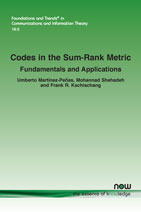Codes in the Sum-Rank Metric: Fundamentals and Applications
By Umberto Martínez-Peñas, University of Valladolid, Spain, umberto.martinez@uva.es | Mohannad Shehadeh, University of Toronto, Canada, mshehadeh@ece.utoronto.ca | Frank R. Kschischang, University of Toronto, Canada, frank@ece.utoronto.ca
Abstract
Codes in the sum-rank metric have attracted significant attention for their applications in distributed storage systems, multishot network coding, streaming over erasure channels, and multi-antenna wireless communication. This monograph provides a tutorial introduction to the theory and applications of sum-rank metric codes over finite fields. At the heart of the monograph is the construction of linearized Reed–Solomon codes, a general construction of maximum sum-rank distance (MSRD) codes with polynomial field sizes. Linearized Reed–Solomon codes specialize to classical Reed– Solomon and Gabidulin code constructions in the Hamming and rank metrics, respectively, and they admit an efficient Welch–Berlekamp decoding algorithm. Applications of these codes in distributed storage systems, network coding, and multi-antenna communication are developed. Other families of codes in the sum-rank metric, including convolutional codes and subfield subcodes are described, and recent results in the general theory of codes in the sum-rank metric are surveyed.
Codes in the Sum-Rank Metric: Fundamentals and Applications
Hamming distance and rank metric have long been used in coding theory. The sum-rank metric naturally extends these over fields. They have attracted significant attention for their applications in distributed storage systems, multishot network coding, streaming over erasure channels, and multi-antenna wireless communication.
In this monograph, the authors provide a tutorial introduction to the theory and applications of sum-rank metric codes over finite fields. At the heart of the monograph is the construction of linearized Reed–Solomon codes, a general construction of maximum sum-rank distance (MSRD) codes with polynomial field sizes. These specialize to classical Reed–Solomon and Gabidulin code constructions in the Hamming and rank metrics, respectively and produce an efficient Welch–Berlekamp decoding algorithm.
The authors proceed to develop applications of these codes in distributed storage systems, network coding, and multi-antenna communication before surveying other families of codes in the sum-rank metric, including convolutional codes and subfield subcodes, and recent results in the general theory of codes in the sum-rank metric.
This tutorial on the topic provides the reader with a comprehensive introduction to both the theory and practice of this important class of codes used in many storage and communication systems. It will be a valuable resource for students, researchers and practising engineers alike.
